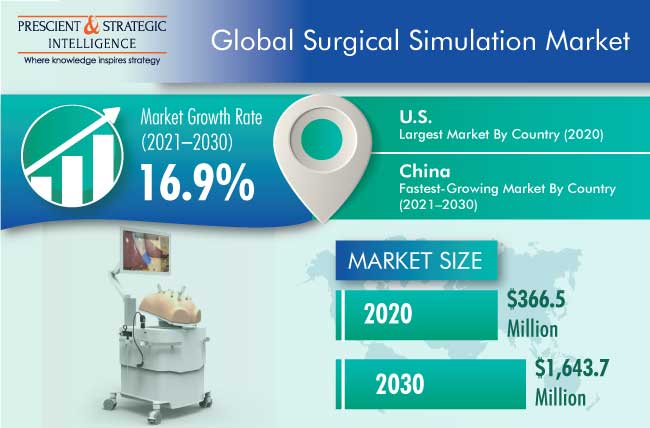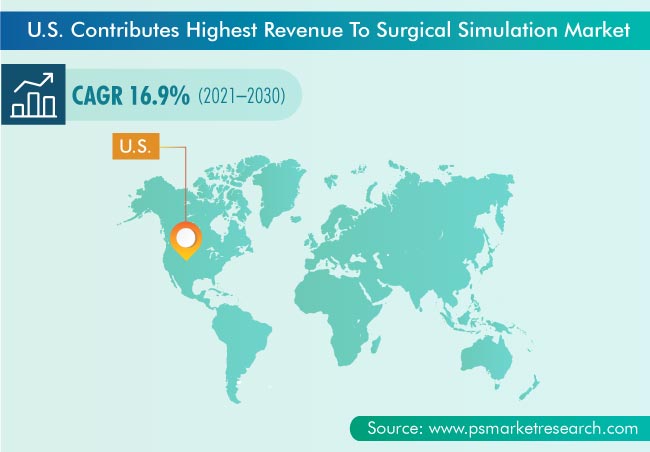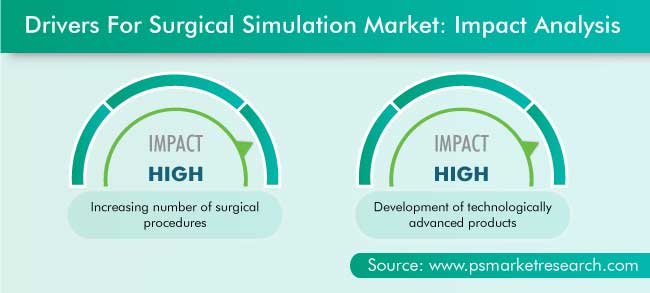Report Code: 11131 | Available Format: PDF | Pages: 242
Surgical Simulation Market Research Report: By Offering (Products, Services), End User (Academic & Research Institutes, Hospitals, Surgical Clinics, Military Organizations) - Global Industry Analysis and Revenue Estimation to 2030
- Report Code: 11131
- Available Format: PDF
- Pages: 242
- Report Description
- Table of Contents
- Market Segmentation
- Request Free Sample
Market Overview
The global surgical simulation market generated $366.5 million revenue in 2020, and it is expected to grow at a CAGR of 16.9% during the forecast period (2021–2030). The key factors responsible for the growth of the market include the increasing number of surgical procedures, development of technologically advanced products, growing geriatric population, and rising preference for minimally invasive surgeries.
The COVID-19 infection has stepped into almost every country, due to which the number of infected patients is rising, which is straining the countries’ healthcare ecosystem and resources. The pandemic has had a mixed impact on the surgical simulation market, visible in the workforce and staffing issues, procedural prioritization, intraoperative viral transmission risk, and impact on surgical education. After a few months, when remote working and virtual communication became popular, virtual simulation was adopted during the pandemic to enhance and strengthen procedural and patient care skills.

Products Category Held Larger Share due to Rising Number of Surgical Procedures
The products category held the larger share in 2020 in the surgical simulation market, based on offering. This is majorly attributed to the increasing demand for surgical simulation products as a result of the rising number of surgical procedures globally.
Academic & Research Institutes To Witness Fastest Growth due to Need to Enhance Clinical Performance of Residents
The academic & research institutes category is expected to witness the fastest growth in the surgical simulation market during the forecast period, based on end user. This will primarily be due to the considerably high demand for educational training programs to enhance the clinical performance of residents.
North America To Lead Market due to Rising Healthcare Expenditure
Geographically, North America is expected to lead the surgical simulation market throughout the forecast period. According to the National Health Expenditure Accounts (NHEA), the U.S.’s healthcare spending grew by 4.6% in 2019, reaching $3.8 trillion, or $11,582 per person. As a share of the nation's gross domestic product, healthcare spending accounted for 17.7%. The increasing collaborations between market players and healthcare associations, surging number of surgical procedures, and growing healthcare expenditure are the major factors driving the regional surgical simulation market.
APAC To Witness Fastest Market Advance due to Growing Medical Tourism Sector
On the other hand, the APAC market is expected to witness the fastest growth during the forecast period due to the growing medical tourism sector and surging geriatric population in the region. Moreover, major players, as a part of their business strategy, are investing in the untapped markets of the region, which, in turn, is contributing to the regional market growth.

Development of Technologically Advanced Products
Major companies in the market are investing in the development of technologically advanced products that can help healthcare practitioners enhance their surgical skills. For instance, in April 2020, Fundamental VR, a digital health company that uses VR to help train surgeons, announced the expansion of its educational platform, named Fundamental Surgery. The platform’s new education modality, @HomeVR, offers educational simulations accredited by the American Academy of Orthopedic Surgeons and the Royal College of Surgeons, on standalone VR headsets, such as Oculus Quest and HTC Vive Focus Plus.
Growing Geriatric Population Is Key Driver for Market
The geriatric population across the world continues to contribute to the rise in the number of surgical procedures, which, in turn, is shaping the market growth. As compared to younger people, the elderly are more susceptible to chronic medical conditions, such as heart diseases, renal disorders, and cancer, which often require surgical intervention. Thus, an increase in their population is likely to result in a considerable demand for surgical simulators.

Increasing Number of Surgical Procedures Driving Simulator Demand
With the increasing prevalence of chronic diseases, the number of surgeries performed globally is also rising. The increasing number of surgical procedures is resulting in a high demand for simulation products to help prevent or reduce medical errors during surgeries, which, in turn, is contributing to the growth of the market.
Rising Preference for Minimally Invasive Surgeries also Playing Important Role in Market Growth
There has been a paradigm shift in surgical procedures in recent years, from conventional surgeries to minimally invasive surgeries, owing to the benefits associated with the latter. Minimally invasive surgeries are video-assisted and, therefore, demonstrate a higher operational accuracy and render less post-operative pain. Moreover, they involve smaller incisions and less scarring, which helps retain the organ’s original structure, without deforming its cellular layers. These factors contribute to the inflating popularity of surgical simulators among healthcare providers and academic institutions.
| Report Attribute | Details |
Historical Years |
2015-2020 |
Forecast Years |
2021-2030 |
Base Year (2020) Market Size |
$366.5 Million |
Market Size Forecast in 2030 |
$1,643.7 Million |
Forecast Period CAGR |
16.9% |
Report Coverage |
Market Trends, Drivers, and Restraints; Revenue Estimation and Forecast; Segmentation Analysis; Country Breakdown; Impact of COVID-19; Companies’ Strategic Developments; Company Profiling |
Market Size by Segments |
By Offering; By End User; By Region |
Market Size of Geographies |
U.S; Canada; Germany; France; U.K.; Italy; Spain; Japan; China; India |
Secondary Sources and References (Partial List) |
U.S. Food and Drug Administration, World Bank Group, World Health Organization, Association for Surgical Education, Centers for Disease Control and Prevention, Emergency Care Research Institute, European Resuscitation Council, Japan Surgical Society, German Society of Surgery, Texas Association of Surgical Skills Laboratories, Society of American Gastrointestinal and Endoscopic Surgeons, Society in Europe for Simulation Applied to Medicine, Society for Simulation in Healthcare, European Resuscitation Council |
Explore more about this report - Request free sample
Market Players Involved in Product Launches to Gain Significant Position
The surgical simulation market is fragmented in nature with the presence of several key players. Some of the major players in the industry are CAE Inc., Mentice AB, 3D Systems Corporation, Simulab Corporation, Limbs & Things Ltd., Medical-X, Voxel-Man, VitaMed Ag, Inovus Ltd., eoSurgical Ltd., 3-Dmed, Laparo Sp. z.o.o., Gaumard Scientific Company Inc., LAERDAL MEDICAL AS, CATHI GmBH, Simendo Company, and Surgical Science Sweden AB.
In recent years, players in the global surgical simulation market have been involved in product launches in order to attain a significant position. For instance:
- In May 2020, iSimulate launched ‘REALITi Go’ to replace the existing version of advanced life support (ALS) systems. REALITi Go is a lightweight, as well as economical version, of the simulated patient monitors of iSimulate. It is a component of the smart, integrated, and modular simulation ecosystem REALITi360, which provides greater flexibility and additional benefits than its predecessor ALSi. For realistic simulations, REALITi Go mimics defibrillators, patient monitors, and ventilators. iSimulate's generic patient monitor screen simulations look, sound, and function like the real thing.
- In February 2020, VirtaMed AG and KARL STORZ SE & Co. KG launched a novel mixed-reality simulator, LapTrainer, for laparoscopic skill training. LapTrainer offers enables medical professionals to acquire key skills with increased efficiency, by the repetition of short simulation sequences.
Key Players in Global Surgical Simulation Market Include:
-
CAE Inc.
-
Mentice AB
-
3D Systems Corporation
-
Simulab Corporation
-
Limbs & Things Ltd.
-
Medical-X
-
Voxel-Man
-
VitaMed Ag
-
Inovus Ltd.
-
eoSurgical Ltd.
-
3-Dmed
-
Laparo Sp. z.o.o.
-
Gaumard Scientific Company Inc.
-
LAERDAL MEDICAL AS
-
CATHI GmBH
-
Simendo BV
-
Surgical Science Sweden AB
Market Size Breakdown by Segment
The global surgical simulation market report offers comprehensive market segmentation analysis along with market estimation for the period 2015–2030.
Based on Offering
- Products
- Endoscopic
- Laparoscopic
- Cardiac
- Gynecological
- Arthroscopic
- Neurological
- Services
- Educational
- Technical
Based on End User
- Academic & Research Institutes
- Hospitals
- Surgical Clinics
- Military Organizations
Geographical Analysis
- North America
- U.S.
- Canada
- Europe
- Germany
- France
- U.K.
- Italy
- Spain
- Asia-Pacific (APAC)
- Japan
- China
- India
- Latin America (LATAM)
- Middle East and Africa (MEA)
The 2030 value of the market for surgical simulation solutions will likely be $1,643.7 million.
On the basis of end user, the surgical simulation industry will witness the fastest growth in the academic & research institutes category.
APAC will be the most-lucrative market for surgical simulation solutions.
The key drivers for the surgical simulation industry are the rising chronic disease prevalence, geriatric population, and surgery volume.
The nature of the market for surgical simulation solutions is fragmented.
Want a report tailored exactly to your business strategy?
Request CustomizationWant an insight-rich discussion with the report author?
Speak to AnalystOur dedication to providing the most-accurate market information has earned us verification by Dun & Bradstreet (D&B). We strive for quality checking of the highest level to enable data-driven decision making for you
Our insights into the minutest levels of the markets, including the latest trends and competitive landscape, give you all the answers you need to take your business to new heights
With 24/7 research support, we ensure that the wheels of your business never stop turning. Don’t let time stand in your way. Get all your queries answered with a simple phone call or email, as and when required
We take a cautious approach to protecting your personal and confidential information. Trust is the strongest bond that connects us and our clients, and trust we build by complying with all international and domestic data protection and privacy laws